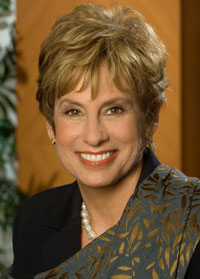Hadassah
President's Column
President’s Column: Our Inner Jewish Passports
 The Midrash tells us that all Jews—those living at the time and all the generations that would come after—were present at Sinai. This story touches many of us because it links us with our founding generation. We draw inspiration and identity by capturing the spirit of the creation of our people.
The Midrash tells us that all Jews—those living at the time and all the generations that would come after—were present at Sinai. This story touches many of us because it links us with our founding generation. We draw inspiration and identity by capturing the spirit of the creation of our people.
We celebrate receiving the Torah on Shavuot, and part of the festivity is reading the Book of Ruth. To remember how our forebears made the decision to accept the Torah, and thereby become Jews, we retell the story of a non-Jewish woman who chose to be one of us.
Though we are one people, we have all witnessed the sin of one Jew denigrating another because of some perceived difference in their Jewishness. It could be they are at the opposite end of the denominational spectrum or have a different political orientation. It may be because they weren’t born Jewish, because of their lifestyle or social class. And yet so much in our tradition reminds us that looking down at another member of the Jewish family because of their difference is wrong.
As a Jewish hero from a nontraditional background, Ruth is not alone. Consider how unlikely a model Queen Esther is for today’s Jewish women. Here is a Jewish girl who enters a beauty contest, conceals her identity and marries a non-Jew. Though she had a Hebrew name—Hadassah—the name Esther uses in public, derived from the Babylonian goddess Ishtar, smacks of assimilation. Rabbi Joseph Telushkin has observed that a modern equivalent would be a Jewish woman named Christine. There’s enough in her story to put off feminists and traditionalists. And yet, she saved the Jewish people.
Ruth and Esther are the only two women to whom books of the Bible are dedicated. Nor is Jewish leadership from outside the mainstream confined to women. David and Solomon were direct descendants of Ruth, the convert. Who had a more assimilated upbringing than Moses, the Egyptian? Theodor Herzl grew up in a home with a Christmas tree. Abraham was the son of an idol maker.
And what of the actual—as opposed to metaphorical—Jews at Sinai? The Bible says the people of the Exodus were a “mixed multitude,” meaning that there were many non-Israelites who opted into the Jewish people.
All of this sends a timely message. Jews are meant to live in the larger world. Our salvation is just as likely to come from the outside, or from beyond today’s communal circle, as from within. No one has a monopoly on truth or wisdom. By taking our chances in the wider world, we may lose some people who opt out of their Jewish identity. But we will gain more. Even among those who drop out, you never know who will come back—or whose grandchildren will grasp at a thread of their heritage and weave it into a Jewish life.
We are a wonderfully diverse people: Religiously observant and secular, liberal and conservative, Sefardi and Ashkenazi, black and white, Jewish born and Jewish by choice. Some Jews may on occasion feel discomfort with those who are from a different stream, but that doesn’t stop us from defending the rights of our people whenever they are threatened. Both our enemies and admirers envy our sense of solidarity as a people.
There are probably more Jews by choice today than at any time in our history. We all either know of or have personal experience of moving from one level of Jewish involvement to another. We are more likely than ever to encounter Jews whose personal profile is different from ours. And our tradition provides us with role models from deep in our past to help make sense of today’s world.
In a hyperactive world where it’s nearly impossible to get three people together for a meeting, it’s comforting to know we were all at Sinai. Whether we observe Shavuot or not, the holiday—which this year begins at sundown on May 18—has left its stamp on the inner Jewish passport of every Jew. H










 Facebook
Facebook Instagram
Instagram Twitter
Twitter
Leave a Reply